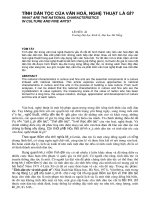what are you most interested in from ray dalios point of view
Bạn đang xem bản rút gọn của tài liệu. Xem và tải ngay bản đầy đủ của tài liệu tại đây (2 MB, 16 trang )
<span class="text_page_counter">Trang 1</span><div class="page_container" data-page="1">
INDIVIDUAL ESSAYSUBJECT: ECO121
Name: Ha Thanh ThanhStudent ID: DS170298Class: BA17D02Lecturer: Le Anh Luyen
</div><span class="text_page_counter">Trang 2</span><div class="page_container" data-page="2">Da Nang, May 23, 2023
ESSAY TEST: A summary of "How the economic machine works" by Ray Dalio. What are you most interested infrom Ray Dalio's point of view? (3 pages)
I. INTRODUCTION:
Ray Dalio, a renowned hedge fund manager and founder of Bridgewater Associates, presents a comprehensive
</div><span class="text_page_counter">Trang 3</span><div class="page_container" data-page="3">understanding of "How the Economic Machine Works". In his widely acclaimed work, Dalio delves into the intricacies of the business cycle, highlighting its mechanisms, and providing insights into how to weather a recession. This essay aims to summarize Dalio's main points while exploring what I find most interesting from his point of view.
II/ ANALYSIS
Ray Dalio introduced the concept of the economic machine, which he defined as the sum of all transactions taking place in an economy. The machine, he emphasizes, operates in cycles, fueled by a delicate balance between productivity, credit, and debt.Dalio divides the economic cycle into four main phases: expansion, recession, debt relief, and recovery.Analysis 1
The economic cycle begins with an expansion phase used by productivity growth, increased lending, and rising debt levels. Dalio explains that during this period, a positive feedback loop is established, in which increased lending and spending stimulates
</div><span class="text_page_counter">Trang 4</span><div class="page_container" data-page="4">economic growth, leading to more borrowing and investment.
Ray Dalio provides a summary of the fundamentals behind how the economy works. In this essay, Dalio provides a comprehensive framework for understanding how the economy works and the principles that drive its cycles. According to Dalio, the economy operates like a simple machine, driven by three drivers: productivity growth, the short-term debt cycle, and the long-term debt cycle.
Dalio emphasized that transactions are the foundation of the economy. Any transaction that involves a buyer exchanging money or credit with a seller for goods, services, or financial assets. The total amount of money spent, including money and credit, drives the economy. Credit plays an important role in the economy because it allows borrowers to increase spending and promote economic growth.
Credit is created when lenders and borrowers enter into transactions in which the borrower promises to repay
</div><span class="text_page_counter">Trang 5</span><div class="page_container" data-page="5">the borrowed amount (principal) alongwith interest. Credit allows borrowers to spend more than they earn, and this increase in spending leads to increased borrowing and economic growth. However, credit also creates cycles in the economy. When borrowing and spending increase too quickly, it can lead to inflation and the economy to overheat. In response, thecentral bank raises interest rates to reduce borrowing and control inflation,eventually leading to a recession.Dalio begins by emphasizing that economies operate in cycles, which hecalls "short-term debt cycles" and "long-term debt cycles." The short-term debt cycle, also known as the business cycle, typically lasts 5-8 years and is driven by changes in credit conditions. These include periods of expansion, characterized byincreased borrowing, spending, and economic growth, followed by periods of contraction marked by a decrease in borrowing, a decrease in spending, and a recession.
Productivity growth is the fundamentaldriver of economic expansion. Increased productivity, achieved
</div><span class="text_page_counter">Trang 6</span><div class="page_container" data-page="6">through technological advancement and improved efficiency, leads to higher output per unit input. Productivity growth is critical to long-term sustainable economic development.
On the short-term debt cycle, Dalio emphasized the role of central banks and their monetary policy. By adjusting interest rates, central banks influence the cost of borrowing and the availability of credit. Lower interest rates make borrowing more attractive, leading to increased spending and investment, which in turn stimulates economic growth. Conversely, higher interest rates discourage borrowing, leading to reduced spending and a contraction ofthe economy.
Regarding the long-term debt cycle, Dalio points out that as debt accumulates relative to income levels, it becomes increasingly difficult to deal with the debt burden. This could lead to a period of leverage reduction characterized by reduced spending, a contraction of the economy, and a potential for default. Understanding and managing this long-term debt
</div><span class="text_page_counter">Trang 7</span><div class="page_container" data-page="7">cycle is critical to avoiding a severe recession.
On the other hand, the long-term debt cycle lasts several decades and involves the accumulation and subsequent reduction of debt. Dalio emphasized that understanding the interplay between debt, spending, andincome is crucial to understanding how the economy works.
Central banks play an important role in managing this cycle through controlling interest rates. However, in the long run, debt tends to grow fasterthan income, leading to a long-term debt cycle. During this cycle, the debt burden increases, but as long as income continues to grow, it remains manageable. Asset values also tend toincrease during this period, leading to periods of economic booms and potential bubbles.
In Ray Dalio's view, understanding how credit, borrowing, and spending work is crucial to understanding the economy. He stressed the importance of productivity growth in the long run but emphasized that credit is the maindriver of short-term economic
</div><span class="text_page_counter">Trang 8</span><div class="page_container" data-page="8">fluctuations. In addition, he emphasized the central bank's role in managing the short-term debt cycle and maintaining economic stability.Analysis 2
As the expansion phase continues, debt levels eventually become unsustainable, leading to a recession. Dalio points out that when debt growth slows or reverses, the positive feedback loop is broken, leading to a decrease in spending, a decrease in investment, and an overall decline in economic activity. This recession is often accompanied by an economic downturn, which is characterized by falling GDP, rising unemployment, andfalling asset prices.
According to Ray Dalio, the recession is a natural part of the business cycle and occurs when the increase in debt and dependence on currency is no longer sustainable. He argues that periods of recession are necessary to clean up and correct problems in the economic system. Dalio has also forecast a global recession in the near future. He argues that the increase in public and private debt in many major
</div><span class="text_page_counter">Trang 9</span><div class="page_container" data-page="9">economies has created a high level of risk and cannot continue forever. He also emphasized the importance of working to correct economic fundamentals and take the necessary measures to create a more sustainableeconomic cycle. However, it should be noted that the forecast of a Recession is a complex matter and cannot be accurate. The global economy depends on many factors, and whether or not a Recession occurs depends on a complex interplay of those factors. Therefore, the work of making decisions and plans based on economic forecasts needs to be done carefully and considering many different factors.
According to Dalio, financial leverage occurs when an economic downturn occurs and causes a sharp decline in asset values. This reduces the ability of individuals, businesses, or financial institutions to pay their debts, leading to an increase in debt that cannot be repaid. When debt is not paid, individuals or businesses may have to sell assets for less than their fair valueto settle the debt, further reducing theasset's value.
</div><span class="text_page_counter">Trang 10</span><div class="page_container" data-page="10">Dalio also refers to the situation when hedge funds or financial institutions buy into an asset with leverage (when using borrowed money to buy the asset) and then reduce the value of that asset. This can create a chain of price declines in the financial system, affecting the economy and creating financial leverage.
Ray Dalio warns that leverage can lead to an economic downturn and increase risks in the financial system. He believes that understanding and managing financial risks is important to avoid falling into financial leverage and create a more sustainable financial system.
Dalio argues that when income growthoutpaces productivity growth, it can create strain on the economy. This imbalance can lead to inflationary pressures, as higher incomes without corresponding increases in
productivity can lead to increased demand for goods and services without corresponding increases in supply. This imbalance between supplyand demand can contribute to an increase in prices and a decrease in purchasing power.
</div><span class="text_page_counter">Trang 11</span><div class="page_container" data-page="11">Furthermore, Dalio suggests that whenincomes grow faster than productivity,it can exacerbate inequality between rich and poor. If most of the increased income goes to a small part of the population, it can widen the gap between the rich and the poor and create economic and social disparities.Dalio's view emphasizes the importance of maintaining a balance between income growth and productivity growth to ensure long-term economic stability and a sustainable distribution of wealth. By focusing on increasing productivity through technological advances, innovation, and investments in humancapital, it is possible to support income growth in a way that is consistent with the overall health of the economy.
Analysis 3
During the debt reduction phase, Dalioemphasized that the excess debt accumulated during the expansion phase needs to be reduced. Debt reliefinvolves debt settlement,
restructuring, or default. This process is necessary to restore the balance
</div><span class="text_page_counter">Trang 12</span><div class="page_container" data-page="12">between debt and income, allowing the economy to stabilize and laying the groundwork for a recovery. This refers to a situation in which the economy successfully transitions from a period of excessive debt to a sustainable level without causing a significant economic downturn. Achieving good debt relief requires a combination of measures such as debtrestructuring, wealth transfers, and appropriate fiscal and monetary policies.
According to Dalio, "beautiful debt reduction" is the process of reducing the amount of debt thoughtfully and intelligently to ensure financial stability and reduce risk. He recommends that in an economic cycle when debt accumulates too much and becomes disproportionate, a nice debt reduction is necessary to rebalance and prepare for the next phase of growth. Beautiful debt relief can be achieved through increasing income, reducing spending, creating cash reserves, or selling unnecessary assets. It is important to
systematically and sustainably reduce debt to ensure that debt payments do
</div><span class="text_page_counter">Trang 13</span><div class="page_container" data-page="13">not put pressure on finances and provide stability for individuals or businesses.
Debt forgiveness plays an important role in restoring financial stability, giving individuals and the economy a chance to recover and move toward growth.
For Dalio, understanding and applying the concept of "beautiful debt relief" isan important part of smart and sustainable financial and investment management.
Analysis 4
The final stage of the economic cycle is recovery. Dalio explains that once debt relief is complete and the debt burden is reduced to a manageable level, economic activity begins to pick up again. Increased lending and spending contributed to new growth and the cycle restarts.
During the recovery phase, the economy begins to recover from the recession and reduce debt. Ray Dalio emphasized that this period was characterized by a new increase in
</div><span class="text_page_counter">Trang 14</span><div class="page_container" data-page="14">lending, spending, and economic activity.
III/ INCONCLUSION
Ray Dalio's book "How the Economic Machine Works" provides a comprehensive framework for understanding the cyclical nature of the economy. His exploration of the four phases of the economic cycle andthe interplay between credit, debt, and productivity provides valuable insights into the drivers of economic growth, recession, and recovery. From Dalio's point of view, I find his focus onthe role of debt and the importance of debt reduction particularly thought-provoking, understanding the cycles, productivity growth, and the interplay of debt, Spending, and policy is criticalto navigating economic fluctuations and making informed investment decisions. By recognizing these key factors, individuals and policymakers can better adapt and respond to the challenges and opportunities that the economic engine presents. shed light on the complexities of maintaining economic stability and resilience.
</div><span class="text_page_counter">Trang 15</span><div class="page_container" data-page="15">In Ray Dalio's view, what particularly intrigues me is his emphasis on the interplay between credit and debt in the business cycle. He highlighted howthe expansion phase, fueled by increased credit and debt creation, setthe stage for the next recession and the need to reduce leverage. Dalio's insights into the importance of debt dynamics in shaping economic cycles provide a valuable lens for
understanding potential vulnerabilitiesand risks in an economy.
Aure. (2022, November 1). How the Economic Machine Works Summary - Ray Dalio - Aure's Notes. Aure’s Notes.
contributors. (2023). Ray Dalio. Wikipedia.
Baller, S. (2014). How the Economic Machine Works A Template for Understanding What is Happening Now Ray Dalio Bridgewater. Kmutnb.









